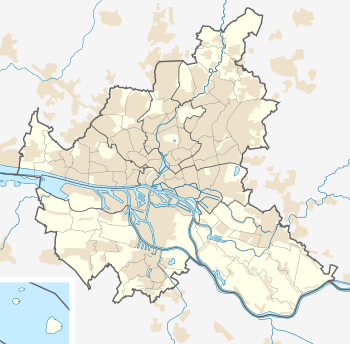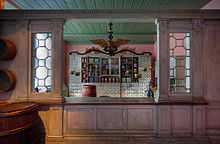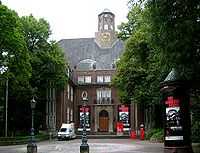Hamburg Museum
| Hamburg Museum | |
|---|---|
| Hamburg Museum | |
|
Entrance of the museum. | |
 Location of Hamburg Museum in Hamburg | |
| Established | 1908 |
| Location | Hamburg, Germany |
| Coordinates | 53°33′04″N 9°58′23″E / 53.551111°N 9.973056°E |
| Type | History museum |
| Website |
www |
The Hamburg Museum, also known as Museum für Hamburgische Geschichte ("Museum for Hamburg History"), is a history museum located in the city of Hamburg in northern Germany. The museum was established at its current location in 1922, although its parent organization was started in 1839. The museum was named hamburgmuseum in 2006. It is located near the Planten un Blomen park in the center of Hamburg.
History

The Society of Hamburg History (Verein für Hamburgische Geschichte), founded in 1839, started compiling the Collection of Hamburg Antiquities (Sammlung Hamburger Altertümer). First exhibits included architectural fragments of the demolished St. Mary's Cathedral and two monasteries.
The main building was designed by Fritz Schumacher and constructed between 1914 and 1922.[1]
The museum was built on the site of the former Bastion Henricus, a part of the baroque fortification which was erected between 1616 and 1625 by the Dutchman Jan van Valckenborgh in order to make the town impregnable.
The museum courtyard was damaged from the great fire in 1842 and fully restored in 1995. A glass dome over the inner courtyard was completed in 1989.
The Hamburg Observatory occupied the area at the Museum from 1825 to 1912 before being moved to Bergedorf. The area was part of the old city wall defences built by the Dutchman Jan van Valckenborgh. These walls were part of Bastion Henricus which was a baroque fortification built between 1616 and 1625.[1] The museum was formerly located at the Johanneum school.
The museum became state-owned under the direction of Otto Lauffer, though this was changed back in 1999.
The museum adopted the name hamburgmuseum, and initials hm, in 2006. In 2008 the museum runs a program called hm freunde (Society of friends of the museum of Hamburg history).[2]
Interior and contents

The museum has many artifacts preserved by the Society of Hamburg History founded in 1839. The Petri portal from Hamburg's St. Petri Church, built in 1604, was built into the museum courtyard in the 1990s.[3]
Permanent Exhibitions

The museum's website lists its permanent exhibitions as:
- Hamburg in the 20th Century
- Hamburg’s Historical Highlights
- Medieval Hamburg
- Hamburg and the Church
- Hamburg in the Early Modern Age
- Baroque Merchant Hall
- Cityscape and Constitution in the 17th Century
- The Dawning of the Modern Age
- The 1842 Fire
- Emigration via Hamburg
- Maritime Trade
- Hamburg in the 21st Century
- Navigation Bridge of the Werner Steamship
- The Arrival of the First Jews in Hamburg
- Enlightenment and Emancipation
- During the German Empire
- The Weimar Republic
- Persecution and the holocaust under the National Socialist regime
- Jewish Schools
- Jews and business in Hamburg
- Jewish Residential Areas and Living Conditions
- The Synagogue
Visitors
The museum takes part in the Long Night of Museums of Hamburg.[4]
See also
References
- ↑ 1.0 1.1 The Museum, Hamburg Museum, accessed December 2011
- ↑ Society of Friends of the Museum of Hamburg History, hamburgmuseum, accessed December 2011
- ↑ Hamburg Museum website, in Englis, accessed November 2012
- ↑ "Lange Nacht der Museen Museum für Hamburgische Geschichte" (in German). Der Museumsdienst Hamburg. Retrieved 2009-08-29.
Further reading
- Horbas, Claudia; Pelc, Ortwin (2002). Es brannte an allen Ecken und Enden zugleich – Hamburg 1842 Zur Ausstellung im Museum für Hamburgische Geschichte, Nov. 2002 bis Febr. 2003 (in German). Heide: Boyens. ISBN 978-3-8042-1114-8.
External links
| Wikimedia Commons has media related to Hamburg Museum. |
- Hamburgmuseum Portal(English)
- Verein der Freunde des Museums für Hamburgische Geschichte e.V.
- Stiftung Historische Museen Hamburg
- Modelleisenbahn Hamburg e.V. (Hamburg Model Railway Society, website only in German)
